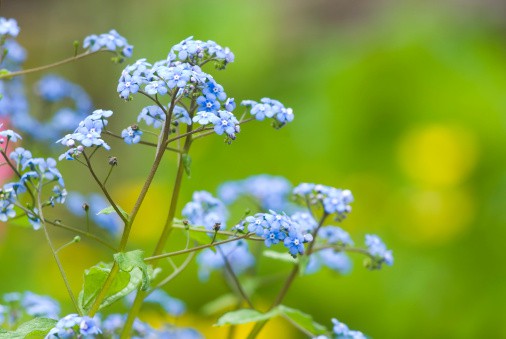Siberian Bugloss (Brunnera Macrophylla) is a charming herbaceous perennial that produces large, heart-shaped leaves that are deep green and sometimes variegated. The blooms are similar to the Forget-Me-Not and make delicate sprays of small bright blue flowers. These flowers look fabulously amongst other vibrantly colored flowers, such as Tulips. They are low-maintenance and easy to grow, hardy in zones three to seven.
The genus name Brunnera is taken from the name of the Swiss botanist Samuel Brunner and the species name Macrophylla is derived from Greek words meaning big-leaved. The alternate old common name “Wild Balsam” is derived from the Latin family name for the species, BALSAMINACEAE.
How to Plant
Siberian bugloss is an easy to grow perennial that prefers partial shade. It can even tolerate full sun in cooler climates. Ideally, it should be given a soil that is rich in organic matter, well drained, and slightly moist. However, it also has good drought tolerance. The ideal pH for this species is 6.0 to 7.5. In hotter climates it does best with sheltered afternoon sun to help keep the soil cool. The preferred temperature range is 15°C to 27°C and it should not be allowed to be exposed to temperatures below freezing.
The best time to plant Siberian Bugloss is during or just after the spring season when temperatures will begin to warm up. To help protect the roots of the plants, it is best to work a 2-inch layer of mulch around the base of the stalk. This will help keep the soil cool and retain moisture. Plant the bulbs 2-3 inches deep with plenty of room between them to encourage healthy stem and root growth. watering shortly after planting to ensure the plants take root.
Meaning and Symbolism
Siberian Bugloss is a symbol of patience and determination, reminding us to stay focused on our dreams and goals. This flower’s deep blue hue is also thought to indicate trust, faithfulness, loyalty and clarity of communication. Its heart-shaped leaves and subtle twirls of starry blue flowers represent a unique kind of love that we often forget to express – the appreciation for our own natural beaty and strength.
History, Mythology, and Religious significance
The Siberian Bugloss is native to the temperate regions of the northern hemisphere and have been in cultivation since the Victorian era. In Greek mythology, the flower has long been associated with Persephone, goddess of vegetation and fertility. According to the Algonquian tribes of Eastern Canada and the United States, the plant was used as a symbol of protection and solace, particularly during times of stress.
In Christianity, the blooms of the Siberian Bugloss have been associated with the Virgin Mary, in particular the sorrows of her life. Its star-shaped blooms are thought to be symbolic of hope and faith for the future.
Flower Varieties and Their Defining Characteristics
The Siberian Bugloss comes in a variety of colors and sizes, from white to blue to pink and magenta. There are also variegated varieties with spots and streaks of different colors. Here are some of the popular names and features of each variety:
- Variegata: Also known as Variegated Siberian Bugloss, this variety has broad, heart-shaped variegated leaves with creamy white margins and dusky blue flowers.
- Langtrees: Also known as Longleaf Siberian Bugloss, this variety produces long, cascading foliage with blue blooms.
- Jack Frost:This beautiful variegated variety has distinct green leaves mottled with white and silver, and produces a profusion of tiny sky blue flowers.
How to Pot and Repot
Repotting or potting Siberian Bugloss should be done in the spring or fall when the roots become crowded. Start by preparing a suitable large container or potting mix with a light and airy texture. Place a layer of drainage gravel in the bottom of the pot, if desired, and then fill it with the potting mix. Make sure to leave at least 2 inches of space between the top of the soil and the rim of the container.
If you are repotting existing plants, gently remove the root ball from the current container and place it in the new pot. Backfill the sides of the pot with more potting mix and firm down gently. Water thoroughly and wait for it to drain completely. Place the pot in a warm and sunny spot, away from any draughts.
How to Prune
If the plant becomes too large, or the leaves start to look less vibrant, pruning may be necessary. If your plant is in a container, you can easily pinch off any rogue flowers and thin out any overworked and withered branches. For larger plants, you can use pruning shears if needed. Make sure to trim back evenly and avoid cutting away more than ⅓ of the overall growth.
To promote bushier growth and prevent the stems from becoming leggy, the entire plant can be cut back to a third to a half of its original size. This should be done in late winter just before the growth season begins, or in late summer or fall just before or after flowering. Cut back the stems evenly across and if necessary, tie them together so that they remain standing upright.
How to Propagate
There are two ways to propagate Siberian Bugloss. Firstly, you can propagate it from seed. To do this, scatter the seeds over the surface of the soil and lightly cover with more soil. Water it in and keep moist until the seedlings emerge. Alternatively, you can propagate it through division. This should be done in late winter or early spring. Gently dig the plant up and divide off any healthy clumps. Replant the divided clumps in their desired locations.
Common Pests and Diseases
The Siberian Bugloss is generally quite hardy and resistant to pests and diseases. However, it is still susceptible to various pests and ailments. Common pests include slugs, aphids, and spider mites. For these pests, the best course of action is to remove them by hand. To prevent disease, make sure the plant is not overwatered and the soil is well-draining. If leaf spots or mildew do appear, spraying them with a fungicide should be enough to clear them.
Frequently Asked Questions
- What is the scientific name for Siberian Bugloss?
The scientific name for Siberian Bugloss is Brunnera Macrophylla. - What type of plant is Siberian Bugloss?
Siberian Bugloss is classified as a perennial plant. - What are the optimal growing conditions for Siberian Bugloss?
Siberian Bugloss prefers partial shade and should be planted in soil that is rich in organic matter, well-drained, and slightly moist. The ideal temperature range is 15°C to 27°C and temperatures below freezing should be avoided.
Table: Fact Sheet
| Name | Data |
|---|---|
| Siberian Bugloss | Brunnera Macrophylla |
| Family | BALSAMINACEAE |
| Plant Type | Perennial |
| Mature Size | 18-24 inches high, 18-24 inches wide |
| Sun Exposure | Partial Shade |
| Soil Type | Rich Organic Matter, Well-drained |
| Soil pH | 6.0 to 7.5 |
| Bloom Time | Spring to Summer |
| Flower Color | White, Blue, Pink, Magenta |
| Hardiness Zones | 3-7 |
| Native Area | Northern Hemisphere |
What we love from Amazon this week
Buy these wonderful flowers directly from Amazon:















